Demolición de represa en Maine permite recuperar hábitat de peces
El río Sebasticook tiene 43,5 millas de largo (70,0 km) y corre por el centro de Maine, en los Estados Unidos. Fluye desde el lago Great Moose Lake a unas 25 millas (40 km) al norte de Winslow, Maine, hasta el río Kennebec en Winslow.
De acuerdo con la asociación "Sebasticook River Watershed Association"
El río Sebasticook es el mayor tributario (985 millas cuadradas) del Kennebec y por lo tanto juega un papel importante en la restauración de las dos poblaciones de peces de los ecosistemas de la cuenca del Kennebec y del Golfo de Maine: los anádromos (aquellos que migran hasta el mar) y los residentes . Debido a su relativa proximidad al bajo Kennebec, un área de drenaje grande, y baja gradiente, este río ha sido históricamente importante para el desove y crianza de varias especies de peces anádromos: sábalo, arenque de lomo azul, sábalo americano, el eperlano arco iris y la lobina rayada (alewife, blueback herring, American shad, rainbow smelt, and striped bass) asociados a los ecosistemas de la cuenca del río Kennebec y el Golfo de Maine . En menor medida, el río Sebasticook proporciona hábitat al salmón del Atlántico.
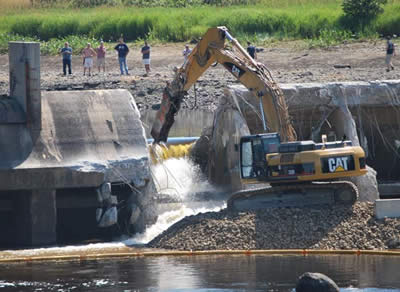
The Sebasticook River is a 43.5-mile-long (70.0 km)[1] river in the central part of Maine, in the United States. It flows from Great Moose Lake, about 25 miles (40 km) north of Winslow, Maine, to the Kennebec River in Winslow.
According to the Sebasticook River Watershed Association:
The Sebasticook River is the largest tributary (985 square miles) to the Kennebec and thus plays an important role in the restoration of both the anadromous and resident aquatic fisheries of the Kennebec basin and the Gulf of Maine ecosystem. Due to its relatively close proximity to the lower Kennebec, large drainage area, and low gradient, this watershed historically contributed a major percentage of available spawning and nursery habitat for anadromous runs of alewife, blueback herring, American shad, rainbow smelt, and striped bass associated with the Kennebec River watershed and Gulf of Maine ecosystems. To a lesser extent, the river provided habitat for Atlantic salmon.
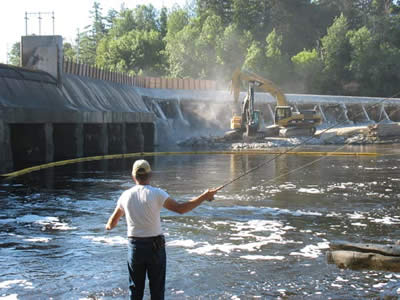
.
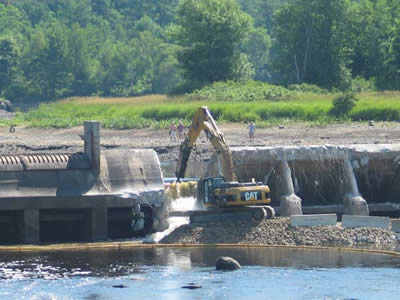
La eliminación de la represa Fort Halifax resultado del mismo acuerdo histórico que permitió la remoción de la represa Edwards. En este acuerdo, el propietario de la represa de Fort Halifax se comprometió ya sea a construir un ascensor de peces o quitar la represa en 2003. Central Maine Power, el propietario de la represa en 1998, pidió la eliminación, ya que creía que Fort Halifax no podría generar energía suficiente para costear el ascensor. FPL Energy Maine Hydro, que adquirió la totalidad de las presas de CMP cuando las centrales eléctricas de Maine fueron desreguladas, también llegó a esa conclusión y decidió eliminar la represa por razones económicas. Sin embargo, fue incapaz de hacerlo por largo tiempo, debido a los cinco años de pleitos con Save Our Sebasticook, un grupo de propietarios de tierras a lo largo del embalse Fort Halifax.
Todas estas demandas han sido resueltas, sin embargo la Federal Energy Regulatory Commission (FERC) dio la orden de retirar el dique completamente el 1 de julio de 2008. FERC también rechazó los intentos de última hora para no eliminar la represa, y en su orden rechazo declaró que: "hemos concluído que la eliminación de la represa permitirá un cuidadoso plan para la restauración del hábitat de los peces anádromos en los ríos Sebasticook y Bajo Kennebec, lo que es la mejor alternativa ". NRCM está de acuerdo, y creemos que los peces a los que se ha bloqueados el Sebasticook durante 100 años estarán de acuerdo también!
Aquí están algunas fotos tomadas el 16 de julio y 17 de 2008, durante la demolición de la represa Fort Halifax:
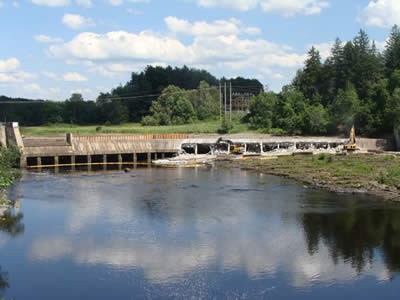 Fort Halifax Dam Removed to Open Fish Passage in Sebasticook
Fort Halifax Dam Removed to Open Fish Passage in Sebasticook
Fort Halifax Dam Removed to Open Fish Passage in Sebasticook
After long legal battle, Fort Halifax Dam in Winslow is breached on July 17, 2008. Photo by Lisa Pohlmann
On July 17, 2008, after more than 5 years of legal battles, FPL Energy Maine Hydro breached the Fort Halifax Dam in Winslow. Finally, this section of the river will flow freely again and native sea-run fish – striped bass, salmon, sturgeon, and shad – will be able to return to waters they have not seen in a century.
The Fort Halifax removal resulted from the same historic settlement accord that allowed the removal of the Edwards Dam. In this accord, the Fort Halifax dam owner committed to either build a fish lift or remove the dam by 2003. Central Maine Power, the dam owner in 1998, requested the provision allowing dam removal because it believed that Fort Halifax might not generate enough power to make paying for an expensive fish lift worthwhile. FPL Energy Maine Hydro, which purchased all of CMP’s dams when Maine’s electric utilities were deregulated, also came to this conclusion and decided to remove the dam for economic reasons. However, it was unable to do so until today because of five years of lawsuits by Save Our Sebasticook, a group of landowners along the Fort Halifax impoundment.
All of these suits have been resolved, however, and the Federal Energy Regulatory Commission (FERC) issued the order to remove the dam completely on July 1. FERC also rejected last minute attempts to stop dam removal, and in their rejection order stated that: “we have previously found that dam removal, which would further a ‘carefully-developed plan’ for the restoration of anadromous fish in the Sebasticook and Lower Kennebec Rivers was the best alternative.” NRCM agrees, and we think that the fish that have been blocked from the Sebasticook for 100 years will agree too!
Here are some photos taken on July 16 and 17, 2008 during the preparation for and breaching of the Fort Halifax dam:
.
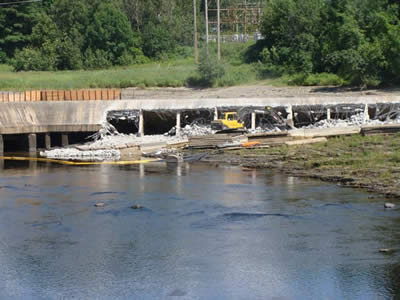
.
Waves of Change: Making a Dam Plan for Fish Habitat
Sep 7, 2012 by http://www.clf.org/blog/tag/dam-removal/
 Image Copyright USFWS
Image Copyright USFWS
An engineer, a politician, and a fish walk into a dam. The engineer says, “We could have built it bigger.” The politician says, “We should have built it cheaper.” Fish don’t talk, but if they did, they probably would have asked for a ladder.
Dams were built in the 18th century to power mills, and in the 1940s to provide cheap electricity and irrigation opportunities – when they were considered great achievements of engineering that would benefit generations to come. Across the nation, dams have been utilized for energy production, flood control, irrigation, and water storage. But, if they are not appropriately planned, sited, and maintained dams can have devastating impacts on fish populations.
In the early 1900s rainbow smelt supported a robust recreational and commercial fishery in the Northeast, but today NOAA Fisheries Service has listed them as a species of concernin this region. One of the problems in the Northeast has been the loss of suitable spawning habitat due to development like dams, which can prevent fish from moving upstream. But now there may be light at the end of the tunnel for rainbow smelt in southern Maine.
At the end of July, the Great Works Regional Land Trust (GWRLT) announced the removal of Shorey’s Brook dam and the restoration of the Shorey’s Brook on Raymond and Simone Savage Wildlife Preserve in Eliot and South Berwick, Maine. Fish surveys are already showing rainbow smelt as far upriver as the former location of the dam and further upstream will be suitable for spawning habitat. If other dam restoration projects across the U.S. can be taken as indicators, rainbow smelt may soon be taking advantage of upstream habitats.
Larger scaled restoration efforts are also progressing in Maine. Earlier this summer,Talking Fish reported the demolition of the Great Works Dam on the Penobscot River in Maine – a restoration effort that will open thousands of miles of upstream habitat to Atlantic salmon and other fish for the first time in almost two hundred years. And, here at CLF we have been working to restore native alewives – an important prey species in both marine and fresh waters for many fish, mammals, and birds – to the St. Croix River in Maine. Read more about that work here.
The pressures on our fisheries are enormous, with overfishing, bycatch, pollution, ocean acidification, and habitat destruction all playing a part. We need a better way to plan in the face of all these different stressors. Partnering among local, regional, state, and federal stakeholders in the Northeast alone has culminated in 299 projects to improve and restore fish habitat in rivers, marshes, and estuaries.
New England’s need for habitat conservation and restoration is great, and other regions have similar challenges. Restoring damaged ecosystems to ecological and economic productivity is a fundamental component of the National Ocean Policy, and one more reason why the National Ocean Policy is right for New England.
.



